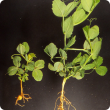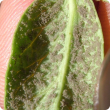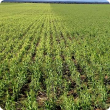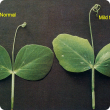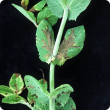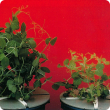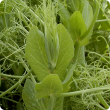Field peas
Field peas are one of the oldest domesticated crops and are now grown in many countries for both human consumption and stockfeed. They have a range of growth habits at maturity, from trailing (which can be difficult to harvest) to erect types. The development of semi-leafless/semi-dwarf types have given growers options with better standing ability which helps with harvesting. In these plants, the leaves have been modified into tendrils which tend to wrap themselves together and hold the plant upright.
There are five seed types of field pea of which only two, Dun and White seed types, are grown in Western Australia. Dun varieties have greenish-brown (dun) seed coats and yellow cotyledons and Australia is currently the only country in the world which grows and exports dun type field peas.
Department of Agriculture and Food, Western Australia contributes to Pulse Breeding Australia to evaluate potential new varieties. Good variety options are available for Western Australian growers suited to a range of soil types and growing seasons.
See Also
Filter by search
Filter by topic
- Pests, weeds & diseases (256) Apply Pests, weeds & diseases filter
- Diseases (247) Apply Diseases filter
- Crop diseases (239) Apply Crop diseases filter
- Fungi (231) Apply Fungi filter
- Production & postharvest (11) Apply Production & postharvest filter
- Plant nutrition (8) Apply Plant nutrition filter
- Herbicides (6) Apply Herbicides filter
- Control methods (6) Apply Control methods filter
- Climate, land & water (6) Apply Climate, land & water filter
- Chemicals (6) Apply Chemicals filter
- Soils (4) Apply Soils filter
- Viruses & virus-like (3) Apply Viruses & virus-like filter
- Pests (3) Apply Pests filter
- Soil constraints (3) Apply Soil constraints filter
- Pest insects (2) Apply Pest insects filter
- Climate & weather (2) Apply Climate & weather filter
- Grains research & development (2) Apply Grains research & development filter
- Managing soils (1) Apply Managing soils filter
- Mites & spiders (1) Apply Mites & spiders filter
- Soil acidity (1) Apply Soil acidity filter
- Wind erosion (1) Apply Wind erosion filter
- Soil salinity (1) Apply Soil salinity filter
- Lupins (1) Apply Lupins filter
- Harvesting (1) Apply Harvesting filter
- Breeding & varieties (1) Apply Breeding & varieties filter
- Bacteria (1) Apply Bacteria filter
- Canola (1) Apply Canola filter
- Frost (1) Apply Frost filter
- Genetic modification (1) Apply Genetic modification filter
- Irrigated crops (1) Apply Irrigated crops filter

